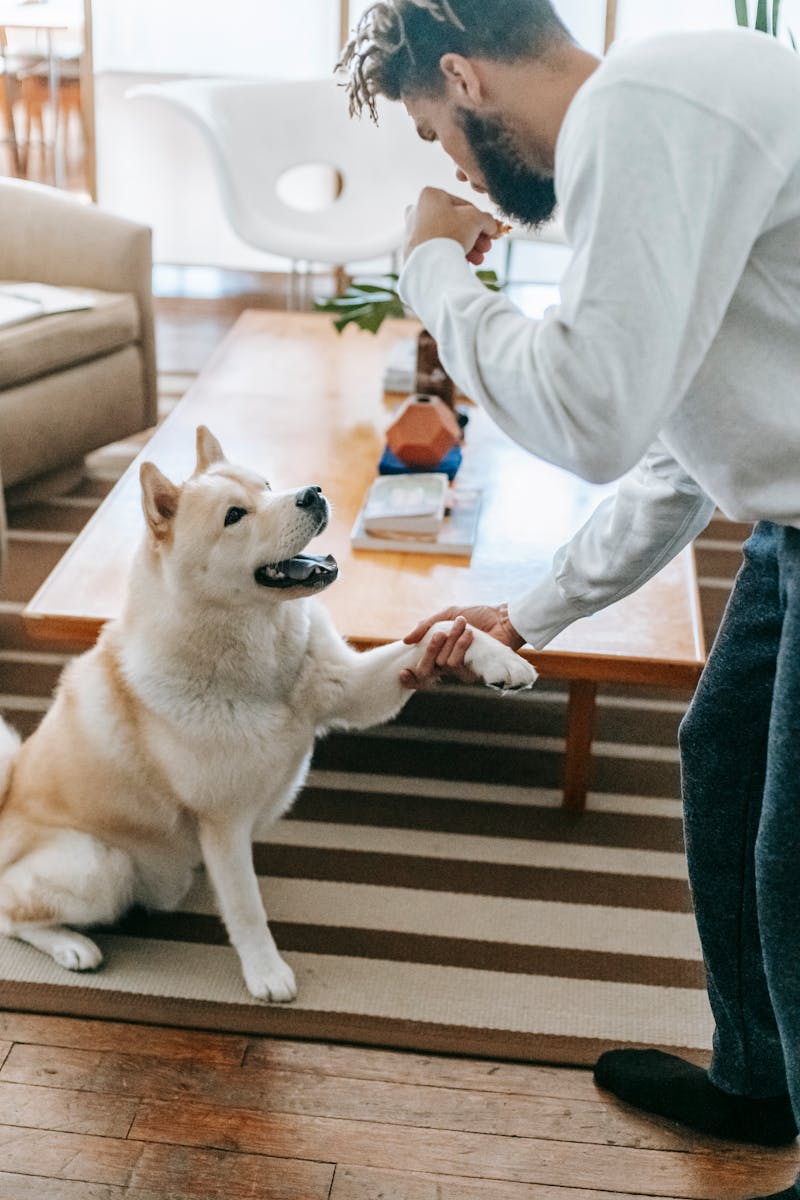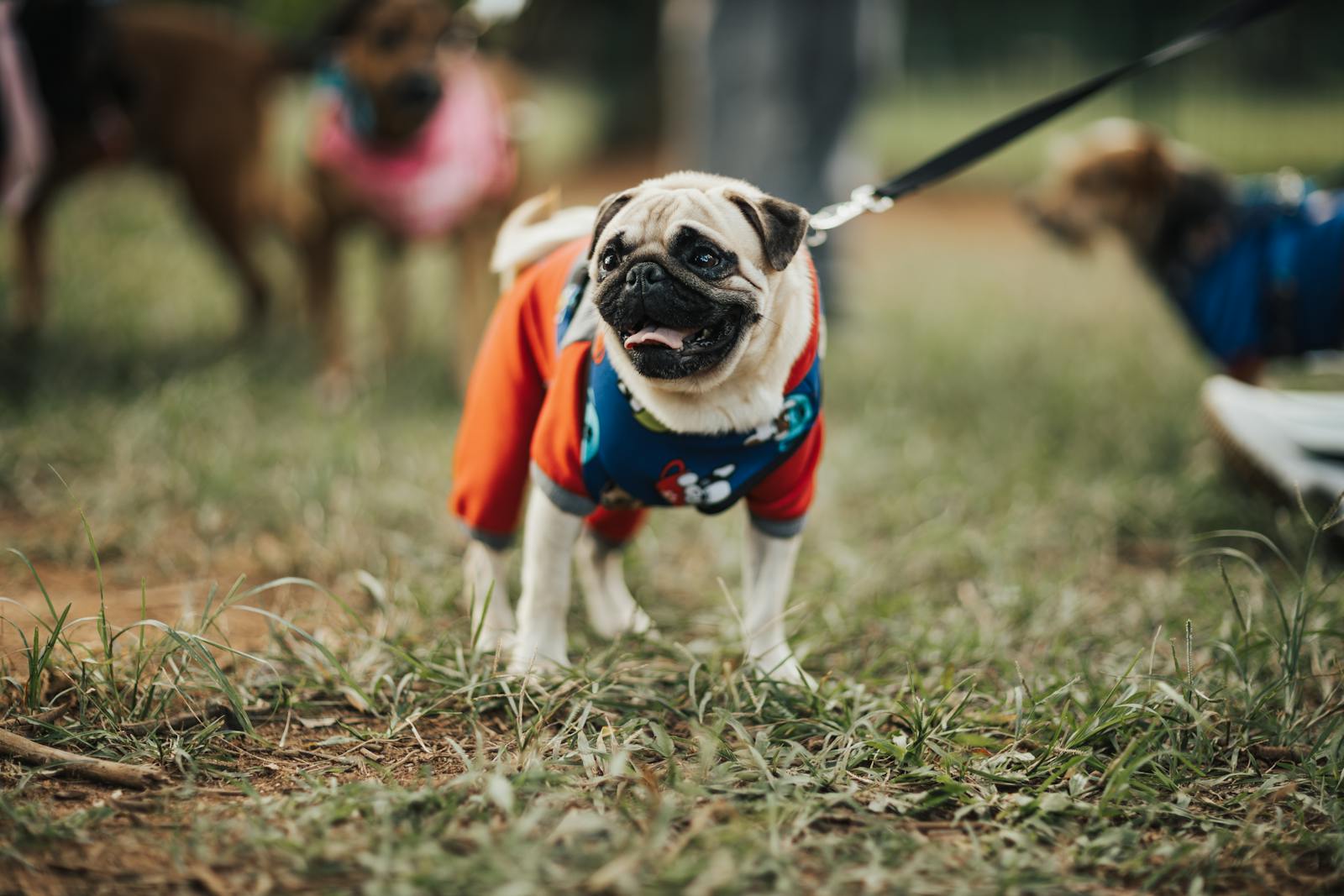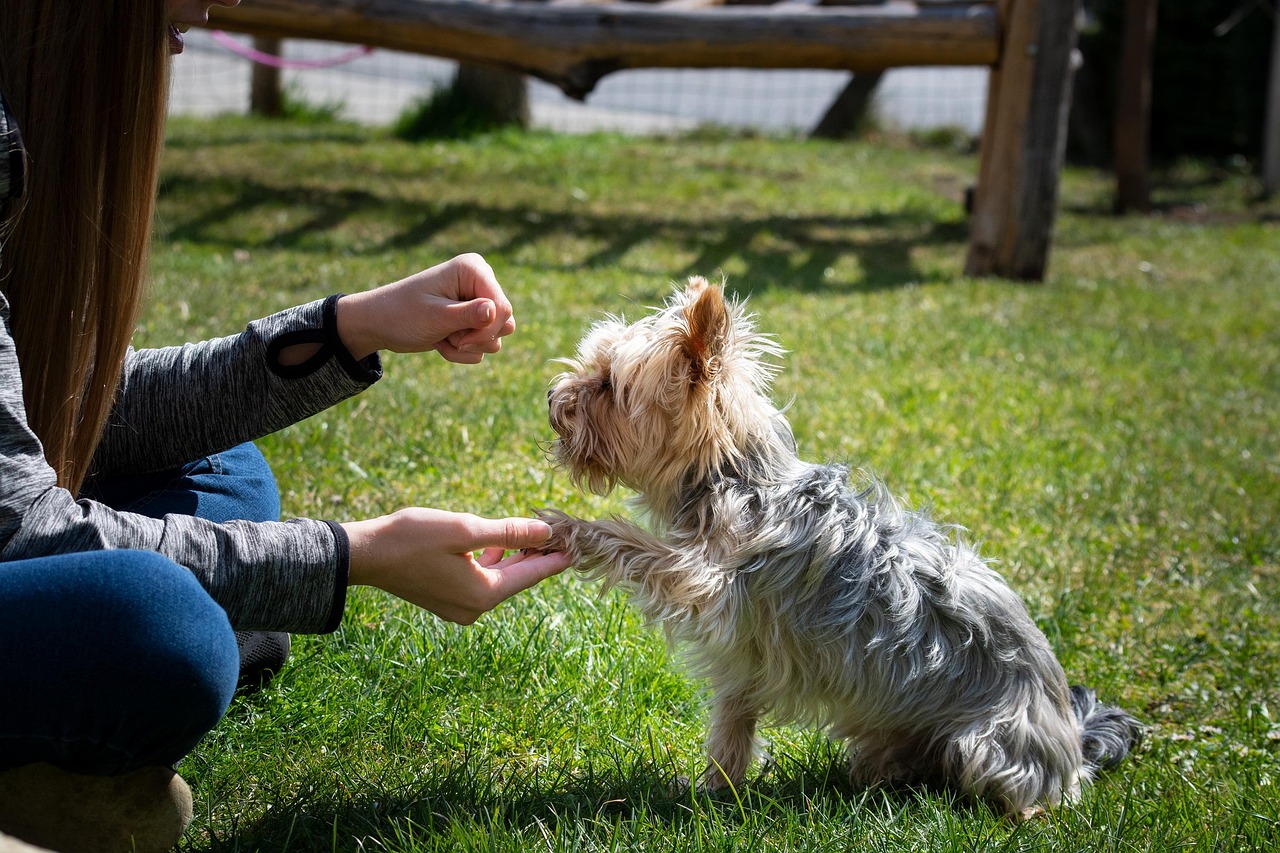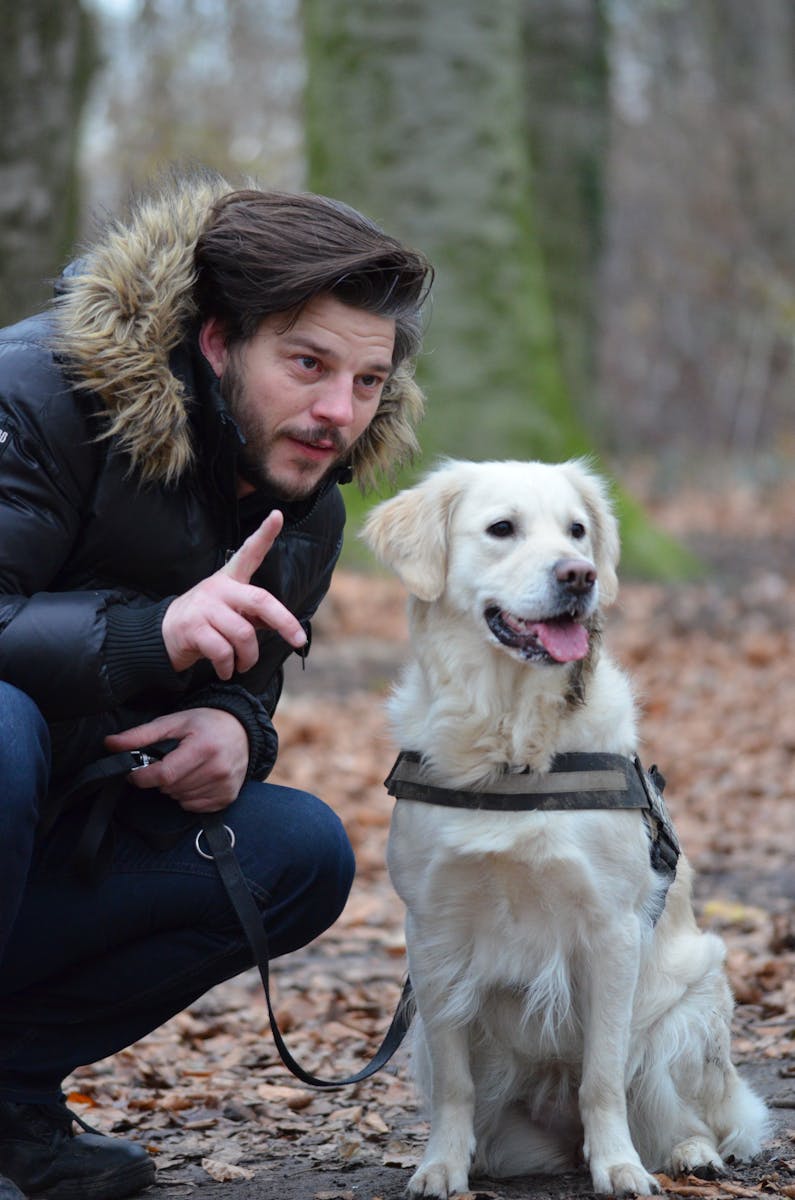How To Use Clicker Training for Better Communication with Your Dog
Understanding Clicker Training: Enhancing Dog Communication for a Happier Relationship
Have you ever watched your dog perform an exciting trick, only to wonder how you could improve your communication and training methods with them? If so, you’re not alone! Dog owners around the world are continually searching for effective ways to train their pets while fostering a deeper bond. Enter clicker training—a method rooted in the principles of positive reinforcement that has transformed the way we communicate with our furry companions. In this blog post, we’ll delve into the world of clicker training, discussing its purpose, benefits, and how you can effectively implement it in your training routine.
What is Clicker Training?
Clicker training is a behavioral training method that uses a small handheld device called a “clicker” to mark desired behaviors. The clicker produces a distinct sound when pressed, signaling to the dog that they have performed a behavior the trainer wants to reinforce. The sound is usually followed by a reward, such as a treat, praise, or playtime, creating a positive association that motivates the dog to repeat the behavior in the future.
Key Components of Clicker Training
- Timing: The click should occur immediately after the desired behavior to create a clear association. This timing helps the dog understand exactly what action they’re being rewarded for.
- Rewards: Effective rewards can be treats, toys, or affection. The key is to find what excites your dog the most so that they are eager to learn.
- Consistency: Using the clicker consistently will help your dog understand the behavior that is being reinforced over time.
The Science Behind Clicker Training
Understanding the science of clicker training can enhance your effectiveness as a trainer. The method leverages the principles of operant conditioning, where behaviors are modified through reinforcement. Positive reinforcement, in this case, encourages the dog to repeat the good behavior by associating it with a positive outcome.
- According to studies in animal behavior, consistent positive reinforcement leads to faster learning.
- Dogs are more motivated when training is fun and rewarding, thereby encouraging a positive attitude towards learning.
Benefits of Clicker Training
- Clear Communication: The use of a clicker provides a clear and immediate signal to your dog, bridging the gap between the behavior and the reward. This helps eliminate confusion that can arise from verbal commands alone.
- Positive Learning Environment: Clicker training is largely stress-free for animals. By focusing on rewarding desired behaviors rather than punishing unwanted ones, you create a safe and supportive environment that encourages learning.
- Versatile Application: This method can be applied to teach a variety of behaviors—from basic commands like “sit” and “stay” to advanced tricks and even agility training. It empowers dog owners to continuously teach their dog new skills throughout their lives.
- Strengthened Bond: Engaging in clicker training sessions helps strengthen the bond between you and your dog. The interactive nature of training fosters trust and understanding, creating a more harmonious relationship.
Getting Started with Clicker Training
Ready to try clicker training with your dog? Here are some actionable tips to help you get started:
Step 1: Choose Your Clicker
Choose a clicker that feels comfortable in your hand and produces a clear sound. Some clickers even have volume adjustments to suit your preference or your dog’s sensitivity to sound.
Step 2: Introduce the Clicker
Before starting any training, let your dog get acquainted with the clicker. Click it and immediately offer them a treat. Repeat this several times until your dog starts to associate the sound with something positive.
Step 3: Start with Simple Commands
Begin with basic commands such as “sit.” When your dog sits, click the device immediately and provide a reward. Practice this in short sessions of 5-10 minutes. Repetition with consistency is key.
Step 4: Add Complexity
As your dog becomes more comfortable with the training, gradually increase the complexity of the commands and behaviors. For example, you can teach them to retrieve items or even perform agility tasks.
Step 5: Generalize the Behavior
Once your dog understands the behavior, practice it in different environments and situations to reinforce the learning. This helps your dog understand that the command applies everywhere—not just in your living room.
Real-World Example: Success Stories with Clicker Training
Many dog owners have discovered the advantages of clicker training. For instance, Sarah, a first-time dog owner, struggled with her high-energy puppy, Max, who couldn’t sit still. After a few weeks of using clicker training, Max learned to sit, stay, and even roll over. Sarah reported not only that training became a delightful bonding experience, but Max also became more obedient and focused over time.
Similarly, Jake, a dog trainer with over a decade of experience, incorporates clicker training into his sessions. He shares that dogs often respond more enthusiastically when they hear the clicker than when he tries to give verbal commands alone. His approach helped boost dogs’ confidence, making them more willing to engage in training and learn new tasks.
Conclusion: Start Your Clicker Training Journey Today!
Clicker training stands out as a compassionate and effective approach to enhancing communication with your dog. By utilizing positive reinforcement, this method fosters a deeper bond and a more enjoyable training experience for both you and your pet. As you venture into this rewarding training method, remember that patience and consistency are essential in helping your furry friend learn and grow.
If you’re ready to transform your dog’s training experience and build a stronger relationship, start with the simple steps mentioned above.

The Science Behind Clicker Training
Understanding the behavioral principles that underpin clicker training is crucial for both novice and experienced dog owners. At its core, clicker training leverages well-established psychological theories to create an effective and enjoyable training experience for both the dog and the handler. In this section, we will explore the key principles involved in clicker training, focusing on positive reinforcement, the psychology of learning, and how these concepts can lead to more successful training sessions.
Positive Reinforcement: The Heart of Clicker Training
Positive reinforcement is the foundational principle of clicker training. It involves rewarding desirable behaviors to increase the likelihood that those behaviors will be repeated in the future. This method stands in stark contrast to punishment-based training, which can lead to anxiety or fear in dogs.
- Concrete Example: When you click the clicker right after your dog sits, you reinforce sitting behavior. By consistently rewarding the action with a treat or praise, the dog learns that sitting equals positive outcomes.
The effectiveness of positive reinforcement lies in its ability to motivate and encourage dogs. Research indicates that animals trained with positive reinforcement not only learn faster but also retain the information longer. When dogs feel encouraged rather than threatened, they are more likely to engage in the learning process enthusiastically.
The Role of Operant Conditioning
Clicker training is built upon the principles of operant conditioning as introduced by behaviorist B.F. Skinner. In simple terms, operant conditioning is a learning principle where behaviors are modified based on the consequences that follow them. Clicker training employs both reinforcement and shaping to create a positive learning environment.
- Reinforcement: When actions are reinforced (e.g., rewarded with a click and a treat), the dog is likely to repeat those actions in anticipation of the same rewards.
- Shaping: This technique involves gradually encouraging a dog to learn complex behaviors by rewarding small steps toward the final goal. For example, if teaching a dog to fetch, you might first reward them for picking up the toy, then for bringing it close, and finally for returning it to you.
Through these mechanisms, clicker training transforms training sessions into collaborative experiences between dogs and their owners, rather than confrontational ones.
Timing and Consistency in Training
Timing and consistency are two critical elements that enhance the effectiveness of clicker training. Dogs operate in the moment, so providing immediate feedback—like clicking the moment they perform a desired behavior—helps them make a clear connection between the action and the reward.
- Key Insight: According to behavior experts, a delayed reward can confuse the dog about what action is being reinforced. For example, if you praise your dog 10 seconds after they lie down, they may not understand that the reward is for lying down, not for being in a different position afterward.
Moreover, consistency in using commands, timing, and rewards helps reinforce learning. With clear signals and constant reinforcement, dogs develop a solid understanding of what is expected from them, which accelerates the training process.
Real-World Applications of Clicker Training
The principles of clicker training can be applied to a variety of real-world training scenarios. For instance, trainers often employ this method to teach and reinforce behaviors in various environments:
- Socialization: Helping dogs learn to interact appropriately with other dogs and people.
- Agility Training: Clicker training can be highly effective in teaching dogs to navigate obstacles with precision and speed.
Conclusion: Embrace the Science of Clicker Training
Understanding the science behind clicker training provides valuable insights that can enhance your training approach. By using positive reinforcement and mastering the techniques of operant conditioning, you can create a more effective training experience that fosters a strong bond between you and your dog.
As you embrace the principles discussed, consider implementing them into your training routine, observing how your dog responds. With patience and practice, clicker training will not only cultivate obedience but also enhance your dog’s overall learning experience.

Choosing the Right Clicker: Decoding the Various Types for Effective Dog Training
When embarking on your journey into the world of clicker training, one of the most important decisions you’ll face is selecting the right clicker for you and your dog. With various types available on the market, understanding their distinctions can help you make an informed choice that meets your training needs. Let’s break down the clickers you might encounter and how to determine which one best fits your specific situation.
Types of Clickers: A Breakdown
Here are the most common types of clickers used by dog trainers and owners, each with its own unique features:
1. Traditional Clickers
These are the classic, small handheld devices that produce a simple click sound when pressed. Generally made of plastic, traditional clickers offer a straightforward and effective way to communicate with your dog.
- Pros: Lightweight and easy to use; suitable for most environments.
- Cons: Some dogs can be startled by the click sound, particularly if they are noise-sensitive.
2. Adjustable Clickers
These clickers come with adjustable volume settings, allowing you to modify the sound to suit your dog’s comfort level. Adjustable clickers are particularly beneficial for training in various settings where ambient noise levels may vary.
- Pros: Versatile; helpful for sensitive dogs; can be used in varied environments.
- Cons: Slightly bulkier than traditional clickers.
3. Clicker with Wrist Strap
These models are equipped with a wrist strap, making them easier to hold and preventing them from getting lost mid-training session. This design is especially advantageous for those who prefer to have their hands free or need to manage multiple dogs or distractions.
- Pros: Convenient for multitasking; less likely to drop.
- Cons: May take some getting used to if you’re accustomed to handling traditional clickers.
4. Smartphone Apps
With the rise of technology, there are now several clicker training apps available for smartphones that simulate the clicking sound. They may also offer features like training timers or a record of your dog’s progress.
- Pros: Multifunctional and convenient; eliminates the need for carrying an extra device.
- Cons: The reliance on a smartphone may not be ideal during high-energy training sessions where distractions are at play.
5. Sound Clickers
Similar to traditional clickers, sound clickers create a distinctive sound, but they may vary in decibel levels and pitch. Some trainers prefer these as they can be more easily heard in noisy environments or outdoors.
- Pros: Variety of sounds available; better suited for challenging training conditions.
- Cons: Dogs may require time to get accustomed to different sounds, which could lead to initial confusion.
Determining the Right Clicker for Your Training Needs
Choosing the right clicker doesn’t have to be complicated. Here are some tips to guide you through the selection process:
Assess Your Dog’s Personality
Consider your dog’s temperament and sensitivity to sound. If your dog is easily startled, a traditional clicker or an adjustable clicker with lower volume settings might be more appropriate. Conversely, if your dog is energetic and responsive to various sounds, you may want to explore sound clickers or apps.
Evaluate Your Training Environment
Think about where you’ll be conducting most of your training. If you’ll primarily train indoors or in quieter settings, traditional clickers will likely suffice. However, if you plan to train outdoors, adjustable clickers or sound clickers may provide the clarity needed to ensure your dog understands the click promptly.
Consider Your Lifestyle
If you’re often on the go, you might prefer a clicker with a wrist strap or even a smartphone app that lets you train wherever you are. The convenience factor is vital to maintaining consistency in your training sessions.
Try Before You Commit
If possible, try out different clickers to see which one feels most comfortable in your hand and produces a sound your dog responds to positively. This hands-on experience can be invaluable in making a choice that feels right for both you and your pup.
Real-World Example: Finding the Perfect Fit with Clickers
Take Jamie, for instance, who had a noise-sensitive puppy named Bella. After trying a traditional clicker, Jamie noticed Bella flinching each time it clicked, leading to frustration on both ends. After consulting a local trainer, Jamie switched to an adjustable clicker and gradually increased the volume as Bella became more comfortable. This simple change made all the difference, as Bella began to respond positively to training, showcasing how crucial the right clicker can be.
Similarly, Mark, an avid hiker, adopted a sound clicker app for his energetic lab, Cooper. He found that using the app during their outdoor training sessions not only minimized the need to carry cumbersome clickers but also kept Cooper engaged without distractions in nature.
Conclusion: Let’s Click Away!
In the end, selecting the right clicker is vital for effective dog training and fostering a positive learning experience for your furry friend. By considering your dog’s sensitivity, your training environment, and your lifestyle preferences, you can choose a clicker that enhances both your communication and the training process.
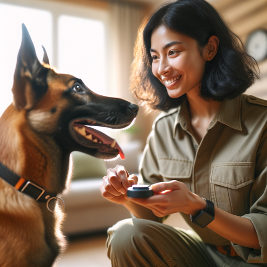
Timing is Everything: The Importance of Timing in Clicker Training
One of the most pivotal aspects of clicker training is timing. The clicker, which serves as a marker, must be activated immediately as the desired behavior is exhibited. This brief moment can significantly influence how quickly and effectively your dog learns. Let’s explore how immediate reinforcement helps with dog learning and behavior modification, transforming your training sessions into fruitful and enjoyable ventures.
Why Immediate Reinforcement Matters
Clear Association
When you click at the precise moment your dog performs the desired action, it creates a clear association between the behavior and the reward. This clarity is crucial for the dog to understand exactly what action they are being rewarded for. For example:
- If your dog sits and you click and treat right away, they know that sitting is the behavior you wish to reinforce.
- Conversely, if there’s a delay, your dog may become confused about which behavior earned them the reward.
Studies have shown that behaviors reinforced immediately are more likely to be repeated. This principle not only enhances learning but also expedites the training process.
The Neurobiology of Timing in Learning
The Role of the Brain
The notion of timing is not just anecdotal—it’s rooted in the neurobiology of animal learning. When a dog performs an action, the brain releases dopamine in response to the reward, cementing a positive experience. The sooner the click follows the action, the more directly that neurological reward is linked to the behavior.
Research indicates that the optimal window for reinforcement is less than a second after the desired behavior is performed. If you click too late, your furry friend may lose focus and not understand why they are being rewarded. Keeping your timing sharp can make a tremendous difference in how effectively your dog learns.
Effective Reinforcement Practices
Tailor Your Timing to Your Dog’s Needs
Every dog is unique, and recognizing the individual learning pace of your pup is essential. Here are some actionable tips to ensure your timing remains effective during training:
- Observe Your Dog: Pay attention to how your dog responds during training sessions. Adjust your timing according to their attentiveness and reaction.
- Practice with Variability: Start in a low-distraction environment and gradually introduce distractions. This helps your dog understand that the behavior is expected in various situations, refining your timing practice.
- Stay Relaxed and Focused: A calm demeanor can influence your dog’s focus. If you are overwhelmed or distracted, you may miss the critical moment for reinforcement.
- Utilize Short Sessions: Dogs have varying attention spans, so short, focused training sessions of 5-10 minutes are often the most beneficial. This keeps their energy high and responsiveness optimal for the entirety of the session.
- Reinforce Continuous Good Behavior: Don’t reserve clicks and treats for just new commands. Reinforce good behavior continually to build a solid understanding.
Real-World Application: Timing in Action
Consider the experience of Lily, a dog owner who implemented clicker training with her anxious rescue dog, Benny. Initially, Benny struggled to engage with commands due to his fearfulness. By focusing on timing, Lily made sure to click the moment he approached her during practice. The instant reinforcement alleviated his anxieties and reinforced his trust, resulting in rapid progress.
In another case, Tom, a professional dog trainer, noted the importance of clicker timing when working with service dogs. He emphasizes, “If I hesitate even a second, the dog might not know what action I’m referring to. That brief moment can make all the difference.” In both examples, adept timing during clicker training yielded noticeable behavioral changes in each dog, underscoring the importance of this training element.
Conclusion: Perfect Your Timing and Transform Training
Mastering the art of timing in clicker training significantly improves your dog’s learning experiences and behaviors. Immediate reinforcement provides clarity, fosters understanding, and speeds up the learning process. As you experiment with timing and refine your clicking skills, remember that patience and practice are key elements in ensuring your success.

Establishing a Positive Association: Linking the Click Sound with Rewards
When embarking on your clicker training journey, one of the most crucial steps is establishing a positive association between the click sound and rewards. It’s essential that your dog understands from the very beginning that the clicking sound signals something good is coming their way. By creating this connection, you lay the foundation for successful communication and effective training. Let’s explore how to do this with clarity and structured steps.
Understanding the Basics of Association
Before diving into the methods, let’s understand why this association is vital. The clicker itself has no inherent meaning to your dog; it’s the positive reinforcement that you pair with it that gives it weight. This is where the power of operant conditioning comes into play. When your dog hears the sound of the clicker followed by a reward, they learn to connect the two. Over time, the click becomes a signal of success.
Step 1: The Introduction Phase
- Familiarization: Start by clicking the clicker without mobile distractions. This can be done while your dog is relaxing or simply in a quiet environment.
- Immediate Reward: After each click, immediately provide a treat. Aim for a reward your dog loves, whether it’s a favorite snack, toy, or affectionate praise.
- Repetition: Repeat the clicking and treating process for several short sessions (5-10 minutes). Aim for 10-15 repetitions in each session. Gradually, your dog will begin to associate the click sound with receiving something good.
- Observe Reactions: Monitor your dog’s body language. Signs of excitement, such as wagging tails, perked ears, or approaching you for a treat, indicate they are beginning to connect the dots.
Step 2: Consistency is Key
To solidify this association, maintain consistency in how you use the clicker:
- Same Clicker, Same Sound: Always use the same clicker. Different sounds may confuse your dog.
- Immediate Response: Click as soon as your dog shows the desired behavior, such as sitting, lying down, or approaching you. This clear timing is crucial for reinforcing the correct behavior.
- Consistent Rewards: Use the same type of rewards during the initial phase. Whether you are using treats or praise, keep it consistent to avoid confusion.
Step 3: Building on the Association
Once your dog understands that the click sound is a precursor to a reward, start incorporating it into actual training scenarios. Here’s how:
- Teaching Basic Commands: Begin with simple commands like “sit” or “down.” When your dog performs the action correctly, click and reward immediately to reaffirm the association.
- Incorporating Excitement: As your dog becomes more responsive to the clicker, increase the level of excitement around training sessions. This can include playing with engaging toys or utilizing their favorite areas for practice.
- Evaluate Progress: Keep an eye on your dog’s response to the clicker. They should show clear signs of anticipation and interest in receiving a click and subsequent reward.
Step 4: Generalization and Advanced Training
Once your dog has a solid grasp of the clicker’s meaning, begin to generalize the command to different environments and situations. This ensures your dog understands that the click sound means a reward, regardless of context:
- Change Settings: Practice in different locations like parks, backyards, or inside the house. This teaches your dog that the clicker applies across various scenarios.
- Increase Challenges: As your dog becomes adept at responding to specific cues, incorporate more complex behaviors like retrieving, agility exercises, or even tricks. Click and reward as they succeed.
Success Story: Positive Experiences with Clicker Associations
Many pet owners find that establishing a positive connection with the clicker transforms both their training experience and their dog’s learning journey. For example, Lisa, an experienced dog lover, adopted a shy rescue dog named Bella. Initially, Bella was apprehensive about training. By focusing on building a positive association with the clicker, Lisa clicked every time Bella showed interest in toys, gradually moving to commands. The results were heartwarming—within weeks, Bella was not only prompt to respond but also exuded confidence around Lisa, eager for clicker sessions.
Conclusion: Embrace the Click!
Establishing a positive association between the click sound and rewards is the cornerstone of effective clicker training. Through familiarization, consistency, and the eventual introduction of commands, you empower your dog to engage fully in the training process. This creates a joyful learning atmosphere that both enhances communication and strengthens your bond.

Basic Command Training: Steps for Training Basic Commands Using the Clicker Method
Now that you understand the foundation of clicker training and its importance in fostering communication between you and your dog, let’s dive into the practical application. The first goal of any training regime is teaching your dog basic commands such as “sit,” “stay,” and “come.” Below is a structured guide outlining the initial steps for effectively training these commands using the clicker method.
Step 1: Training “Sit”
Teaching your dog the “sit” command is often the first step in basic command training. Here’s how you can effectively train this command:
- Get Your Dog’s Attention: Begin by getting your dog’s attention. You can use a treat to draw their focus. Ensure you’re in a quiet environment with minimal distractions.
- Use the Lure: Hold a treat close to your dog’s nose, and slowly move it upwards and slightly back over their head. This will encourage them to naturally lower their back end to follow the treat.
- Mark and Reward: As soon as your dog sits, immediately click the clicker, and reward them with the treat. This immediate reinforcement will create a positive association with the command.
- Repeat and Practice: Continue the exercise several times in short bursts, offering praise and treats each time they successfully sit on command. Aim for 5-10 minutes of training, a few times a day.
- Introduce the Command: Once your dog consistently sits when lured with a treat, introduce the verbal command “sit” just before you perform the motion. Slowly phase out the lure, relying on the command alone.
Step 2: Training “Stay”
Once your dog masters the “sit” command, the next step is to teach them the “stay” command. This command helps with impulse control and is essential for the dog’s safety. Here’s how to go about it:
- Start from “Sit”: Have your dog sit as the starting position for this command. This makes it easier since they are already in a controlled position.
- Introduce the Command: Show the palm of your hand towards your dog and say “stay” in a firm but friendly tone.
- Take a Step Back: Gradually take a small step back—doing this while staying visible to your pup.
- Mark and Reward: If your dog remains seated, click the clicker and reward them. If they move, calmly lead them back into position without reprimanding.
- Increase the Distance: Over time, increase the distance and duration of the stay, clicking and rewarding when they maintain the position. Practice this in different areas and with varying distractions to reinforce the behavior.
Step 3: Training “Come”
The “come” command is vital for your dog’s safety and your peace of mind. Here’s how to teach it effectively:
- Utilize the Leash: Start in a secure area. Attach a leash to your dog, and use a long lead if available to give them some space to move.
- Show Enthusiasm: Get down to your dog’s level and call them using an upbeat tone, “Come!” while gently pulling on the leash.
- Mark and Reward: As soon as your dog approaches you, click the clicker and offer a reward. Be enthusiastic with your praise!
- Establish the Command: Use the command every time you call your dog for other activities, such as mealtime or playtime, reinforcing the connection between the action and the command.
- Gradually Remove the Leash: Once your dog reliably comes when called, practice without the leash in a secure, enclosed area to build confidence. Gradually introduce distractions and practice in various environments.
Bonus Tips for Successful Command Training
- Patience and Consistency: Every dog learns at their own pace. Patience is key. If your pup struggles, go back a step in the training process rather than getting frustrated.
- Short, Frequent Sessions: Aim for short sessions (5-10 minutes) multiple times a day. Dogs learn best in compact, enjoyable training bursts rather than prolonged sessions.
- Positive Reinforcement: Always end on a positive note. If your dog successfully executes a command, celebrate their achievement, whether with a treat, praise, or play.
- Practice Regularly: Reinforcement of learned commands through regular practice is essential. Make it a part of your daily routine to keep skills sharp.
Real-World Example: Success Stories with Clicker Training
Following these foundational steps can lead to tremendous success. Take the story of Emma, a dog owner who struggled with her Beagle, Daisy, who was notorious for ignoring commands. After starting clicker training with basic commands like “sit,” “stay,” and “come,” Emma quickly noticed that Daisy became increasingly responsive. Within just a few weeks, Daisy transformed from a willful puppy to a well-behaved companion, eager to learn and eager to please.
Similarly, Mark, a veterinarian, integrates clicker training into his behavioral consultations. He observes that clients report quicker responses to commands and improved behavior, highlighting the method’s efficacy. He mentions how rewarding dogs immediately after they perform the desired action fosters a strong bond of trust and cooperation.
Conclusion
Implementing clicker training for basic commands such as “sit,” “stay,” and “come” is a powerful way to enhance your relationship with your dog. By following these clear, structured steps, you lay the groundwork for a well-trained pet who understands and responds to your commands. Remember, consistency, patience, and positive reinforcement are critical to enjoying a fruitful training experience.

Adding New Behaviors Gradually into Training Sessions with Clicker Training
Once you’ve established a solid foundation in clicker training with your dog, the next step is to start incorporating new behaviors. Adding new behaviors gradually can enhance your training sessions, making them more dynamic and engaging for both you and your dog. In this section, we will explore effective strategies to introduce new behaviors using the clicker to mark desired actions.
Understanding the Gradual Approach
Introducing new behaviors step-by-step provides clarity and structure to your training sessions. This method helps prevent overwhelming your dog while promoting confidence as they learn to respond to your cues.
- Identify the New Behavior: Start by selecting specific behaviors you wish to introduce. This could include anything from advanced commands like “play dead” to fun tricks such as “spin.” Clearly defining the behavior will guide your training sessions.
- Break Down the Behavior: Decompose the new behavior into smaller, manageable steps. For example, if you want your dog to roll over, you can break it down into:
- Lying down
- Turning on their side
- Completing the full roll
Using the Clicker Effectively
Now that you’ve established your new behavior and broken it down into smaller components, it’s crucial to reinforce each step with your clicker. Here’s how you can do it:
- Marking Success: As soon as your dog successfully performs a step towards the new behavior, promptly click the clicker. This action signifies to your dog that they are on the right track.
- Reward Immediately: After clicking, reward your dog with a treat, praise, or favorite toy. It’s essential that the reward closely follows the click to strengthen the association between the behavior and the reward.
- Repeat Until Mastery: Practice each step multiple times until your dog performs it consistently. For example, if you’re teaching your dog to lie down as part of rolling over, ensure they can reliably go from a sitting position to lying down before progressing.
Introducing the Full Behavior
Once your dog has mastered the individual components, it’s time to bring them together to form the complete behavior:
- Chain the Behaviors: Begin by introducing the first step of your new behavior, and as soon as your dog completes it successfully, prompt them to continue onto the next step. For example, if your command is “roll over,” start with “down,” and once they lie down, gently encourage them to roll to their side.
- Click at Each Stage of Completion: As your dog moves through each step of the full behavior, click at each stage to mark their progress accurately.
- Gradually Fade the Prompts: As your dog becomes more confident, start to reduce physical guidance or verbal prompts. Allow your dog to initiate the behavior based on cues you’ve trained them on, relying on the clicker and reward as the primary motivators.
Real-World Example: Gradual Learning with Clicker Training
Take the case of Emma, who wanted to teach her dog Charlie to fetch specific items. Instead of expecting Charlie to retrieve his toy right away, she started by breaking the task into steps:
- First, Emma used the clicker and a treat to reinforce Charlie picking the toy up.
- Next, she clicked and rewarded him for bringing the toy a few steps closer to her.
- Over several sessions, Emma continued to click and reward for each step until Charlie could retrieve the toy on command.
By applying gradual reinforcement and taking baby steps, Emma not only taught Charlie a new skill but also deepened their training bond and enhanced Charlie’s excitement for learning.
Training in Different Environments
Once your dog comprehends the new behavior, it’s crucial to practice it across various locations and scenarios to reinforce learning and adaptability. This helps ensure your dog can generalize the behavior, meaning they will perform it regardless of their environment. Here’s how to practice effectively:
- Choose New Settings: Move training sessions from home to quieter, public spaces, like a park or a backyard. Gradually increase distractions as your dog becomes more confident.
- Vary Timing: Incorporate the new behavior into daily routines or events—ask your dog to perform in different contexts, enhancing their adaptability.
Monitoring Progress and Adjusting Sessions
It’s essential to monitor your dog’s progress closely. Here are a few tips to assess and adjust your training sessions effectively:
- Stay Patient: Always remember that each dog learns at their own pace. If progress stalls, revisit earlier steps or increase rewards to rekindle motivation.
- Mix Up Rewards: As your dog becomes proficient with the new behavior, consider varying the rewards. Switch up treats or even use play as a reward to keep training exciting.
- Check for Comprehension: If your dog consistently struggles with a specific step, review that segment to ensure clarity and reinforce learning.
Conclusion: Embrace the Journey of Learning Together
Incorporating new behaviors gradually into clicker training sessions is a rewarding experience that enhances communication and understanding between you and your dog. By breaking down tasks, using the clicker effectively, and creating an adaptable training environment, you pave the way for a successful and enjoyable learning journey.

Breaking Down Complex Tasks: Guide on How to Use Clicker Training to Teach Complex Behaviors by Breaking Them Down into Manageable Parts
Teaching your dog complex behaviors can seem daunting, but with clicker training, you can break down these tasks into manageable parts that make learning easier for both you and your furry friend. This method not only enhances clarity in communication but also cultivates an environment where your dog feels comfortable and eager to learn. In this section, we will explore effective strategies for using clicker training to teach complex behaviors by simplifying the learning process.
Understanding the Concept of Task Breakdown
When tackling complex behaviors, it’s crucial to break them down into smaller, more manageable parts—often referred to as “shaping.” Each tiny step that leads to the final behavior allows your dog to grasp what is expected without becoming frustrated or confused.
Step 1: Identify the Final Behavior
Before you can begin shaping the behavior, clearly define what you want your dog to achieve. Whether it’s a trick like “play dead” or a more functional task like “fetch my slippers,” having a clear end goal in mind sets the stage for your training.
Step 2: Breakdown the Complex Behavior
Once you have identified the final behavior, break it down into smaller steps. For example, if you want to teach your dog to “roll over,” you can break it into the following parts:
- Laying Down: Start by teaching your dog to lie down on command.
- Turning onto Their Side: Once they are comfortable lying down, encourage them to lean to one side.
- Full Roll: Finally, guide them to complete the roll.
By focusing on one small step at a time, your dog will find the process less overwhelming.
The Importance of Timing and Rewards
In clicker training, timing is everything. To reinforce each small step effectively, you need to click at just the right moment. Here’s how to maximize your clicker training during the breakdown of complex behaviors:
- Click at the Right Moment: As your dog performs a desired action, click the clicker immediately. For example, click when your dog lies down, then reward them right after.
- Use a Variety of Rewards: Keep your dog motivated by using different types of rewards. This could be a favorite treat, praise, or even a quick game of fetch after a successful training session.
Step 3: Progress Through the Stages
After your dog has successfully mastered the first small behavior, move on to the next part. With our “roll over” example:
- Once your dog consistently lays down, start prompting them to lean to one side. Click and reward them when they do.
- Once this behavior is solid, encourage them to complete a full roll, marking the achievement with a click and a reward.
Patience and perseverance are key here; some dogs may take longer to master certain parts than others. But remember, every successful click is a step in the right direction!
Real-World Application of Breaking Down Complex Behaviors
Many dog owners have successfully utilized this technique to teach complex behaviors. Take Lisa, who aimed to train her rescue dog, Charlie, to retrieve the newspaper. By breaking this task into bite-sized pieces, she started with the command “fetch” when she threw a ball. Once Charlie grasped fetching the ball, Lisa gradually incorporated the newspaper into the game. After several weeks, Charlie was confidently fetching his daily paper, much to Lisa’s delight!
Step 4: Generalization of the Behavior
Once your dog has mastered the complete behavior in a controlled environment, it’s essential to practice in different locations and contexts. This generalization phase helps your dog understand that the command holds the same meaning regardless of the situation.
- Practice in Various Locations: Take your training outside—try it in your backyard, at the dog park, or even during family gatherings.
- Incorporate Distractions: Gradually introduce distractions to ensure your dog can perform the behavior in real-life scenarios.
The Power of Positive Reinforcement
Clicker training can significantly change your approach to teaching complex behaviors through the reinforcement of positive experiences. Dogs respond enthusiastically to this learning style, making them more likely to repeat desired actions. Consistency is pivotal; each time you break down a task, remember to click and reward. Here’s a quick recap of essential strategies:
- Define the End Goal: Clearly outline what behavior you aim to teach.
- Shaping: Break down the skill into small, achievable steps.
- Click at the Right Time: Reinforce desired actions with immediate clicks and rewards.
- Generalize the Learning: Practice across various environments and contexts to ensure consistency.
Conclusion: Start Your Clicker Training Journey Today!
Incorporating clicker training into your sessions can make a remarkable difference in teaching complex behaviors. By breaking down tasks into manageable bits, you can enhance communication and strengthen your relationship with your dog. Don’t hesitate to share your own experiences with breaking down behaviors or ask questions about the process in the comments below! Join our community of engaged dog lovers and let’s support each other on our training adventures—be sure to share this guide with fellow dog owners eager to unlock the potential of their pets!

Consistency is Key: The Importance of Reliable Cues and Signals During Training Sessions
Once you’ve embraced the principles of clicker training, it’s essential to understand the significance of consistency in your training sessions. Consistent cues and signals play a pivotal role in reinforcing your dog’s understanding of commands, behaviors, and the very essence of learning itself. As we dig deeper into this topic, you’ll discover how clear communication can lead to quicker learning and a stronger connection with your furry friend.
Understanding Cues: What Are They?
Cues are signals or commands that instruct your dog to perform a specific behavior. They can be verbal, like “sit,” or non-verbal, such as a hand gesture. The effectiveness of these cues largely depends on your ability to deliver them consistently.
The Role of Consistency in Cues
- Reinforcing Behaviors: When you consistently use the same cues, your dog learns to associate those cues with specific actions. This leads to a clearer understanding of what is expected and makes reinforcement more effective.
- Reducing Confusion: Imagine telling your dog to “come” one day and “here” the next. Inconsistent signals can confuse your dog, making it challenging for them to learn. Consistency eliminates guesswork and builds confidence.
- Establishing a Routine: Dogs thrive on routine. A consistent training approach creates a structured environment where your dog knows what to expect. This predictability fosters a sense of security and speeds up the learning process.
Tips for Maintaining Consistency in Training
To ensure your training sessions are effective, consider the following actionable tips:
1. Use the Same Commands
Always choose the same word or phrase for a command. For example, if you decide to use “down” instead of “lie down,” stick to it. This reinforces the specific behavior you’re teaching.
2. Be Uniform in Gestures
If you’re using hand signals alongside verbal commands, maintain the same gesture for the same command. Variations in your gestures can confuse your dog. For instance, if your hand signal for “sit” is raised palm, keep it consistent throughout all training sessions.
3. Keep Training Sessions Structured
Design your training sessions in a manner that allows for repetition and practice of the same cues. Short, frequent sessions are more effective than long, infrequent ones, so focus on quality over quantity.
4. Always Reinforce Correct Behaviors
When your dog performs the desired behavior in response to a cue, reward them immediately with a click and treat. This not only reinforces learning but also encourages them to associate the cue with positive outcomes.
Real-World Example: Consistency in Action
Consider Kate, a dog owner who decided to train her rescue dog, Bella, using clicker training. At first, Kate used a mix of verbal commands and hand signals that often changed. After realizing the confusion it caused Bella, Kate dedicated herself to using consistent cues for each behavior. Within weeks, Bella was not only responding more reliably but also seemed more relaxed during training sessions.
Another example is John, a seasoned dog trainer who emphasizes the importance of consistency in his workshops. He often shares stories of clients who struggled to get their dogs to obey, only to find that minor inconsistencies in commands were at the root of the issue. Once he helped them establish clear, consistent cues, their dogs quickly learned and complied with commands they previously ignored.
Importance of Timing and Clarity
Beyond using consistent cues, timing and clarity in your signaling can dramatically impact your dog’s understanding.
- Immediate Feedback: When you use the clicker, ensure that it follows right after the desired behavior. This helps your dog connect their action with the reward effectively.
- Stay Calm and Clear: Dogs can pick up on your emotions and stress. Keep your tone calm and clear, ensuring that your cues aren’t muddled by varying inflections or emotions.
Building a Training Foundation with Consistency
Ultimately, consistency in cues, timing, and clarity creates a robust foundation for your dog’s learning journey. The combination of consistent cues and clear communication reinforces understanding and builds a trusting relationship between you and your dog.
With patience and dedication, you can transform your training sessions into meaningful interactions that strengthen your bond and boost your dog’s confidence.
As you reflect on your own experiences, think about your training sessions. How are you ensuring consistency in your cues? Have you noticed any changes in your dog’s behavior when you adopt a more structured approach? Share your thoughts and experiences in the comments below—we’d love to hear how consistency has made a difference in your training! Don’t forget to share this valuable information with fellow dog owners interested in enhancing their training practices!

Using Clicker Training for Problem Behaviors
Even the most well-behaved dogs can exhibit problem behaviors, which often stem from boredom, anxiety, or lack of training. Common issues like excessive barking, chewing, or jumping can disrupt daily life and strain the bond between you and your canine companion. But fear not! Clicker training is not only an effective way to teach desired behaviors, but it can also help redirect unwanted actions by promoting positive reinforcement. In this section, we will explore how clicker training can effectively address these common behavioral problems and illustrate effective techniques to implement.
Addressing Excessive Barking
Excessive barking can stem from various triggers—like boredom, anxiety, or simply wanting attention. Instead of scolding your dog for barking, clicker training can provide a constructive alternative that focuses on rewarding quiet behavior.
- Identify the Trigger: The first step is understanding what causes your dog to bark. Is it the doorbell? Other dogs? Determine the stimulus to work effectively.
- Teach the “Quiet” Command:
- When your dog starts barking, wait for a moment of silence, even if brief.
- Click as soon as they stop barking and provide a treat.
- Repeat this during each instance of barking. Over time, they will learn that being quiet earns rewards.
- Practice in Various Situations: Gradually introduce distractions similar to the triggers that usually cause barking. This reinforces the behavior you want under different circumstances.
Curbing Destructive Chewing
Destructive chewing often indicates that a dog is bored or anxious. Clicker training can shift their focus away from chewing inappropriate items to engaging with suitable toys.
- Redirection to Appropriate Chew Toys:
- When you see your dog chewing on an inappropriate item, calmly redirect them to a designated chew toy.
- As they begin chewing the appropriate toy, immediately click, and offer praise or a treat.
- Consistency is Key: Continue this process consistently. If your dog starts to chew an item they’re not supposed to, redirect them quickly—this process helps them understand what’s allowable.
- Increase Engagement: Use interactive toys that engage your dog. Consider puzzle toys filled with treats or toys that dispense rewards when interacted with to keep them mentally stimulated.
Jumping Up on People
Jumping can be a sign of excitement and eagerness to greet, but it can also be overwhelming for guests. Using clicker training can teach your dog to greet people politely.
- Teach an Alternate Behavior:
- When a guest arrives, keep your dog on a leash if necessary to manage their excitement.
- Wait for your dog to sit naturally or encourage them to sit. As soon as they sit, click and reward them.
- Practice this consistently with multiple guests, allowing them to see that sitting earns attention.
- Gradual Exposure: Practice in various environments and with different people, ensuring your dog understands that sitting quietly rather than jumping is desirable behavior.
Benefits of Using Clicker Training for Problem Behaviors
Utilizing clicker training to combat problem behaviors not only creates desired actions but enhances the overall training experience.
- Positive Reinforcement: This method encourages your dog to repeat good behaviors through rewards, creating a proactive rather than reactive training atmosphere.
- Strengthened Communication: The clicker serves as a clear communication tool between you and your dog, eliminating confusion that can arise with verbal commands alone.
- Stress-Free Learning: By focusing on rewarding good behavior instead of punishing unwanted actions, you foster a more relaxed environment for learning—contributing to a happier dog.
Real-World Example: Redirecting Problem Behaviors
Many dog owners have successfully utilized clicker training for redirecting problem behaviors. For instance, Emily faced constant barking from her rescue dog, Bella. After realizing that Bella barked at the mailman due to excitement, Emily began clicker training. Whenever Bella stayed quiet as the mailman approached, she clicked and rewarded her with a treat. In months, Bella learned to stay quiet, even during mail deliveries.
Similarly, Josh adopted a playful puppy, Charlie, who loved chewing shoes. Through clicker training, he redirected Charlie’s attention to a suitable chew toy every time he reached for a shoe. Over time, Charlie learned exactly which items were off-limits and developed healthy chewing habits.
Conclusion: Start Your Clicker Training Journey Today!
Clicker training is an invaluable tool in addressing problem behaviors in dogs. By reshaping undesirable actions through positive reinforcement, you create a rewarding training experience that enhances your dog’s learning and strengthens your bond. Remember that patience, consistency, and practice are key to fostering long-lasting behavioral changes.
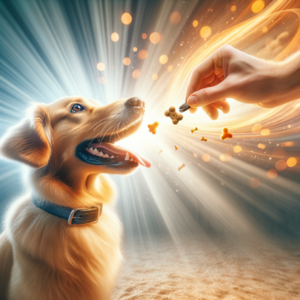
Training with Distractions: Strategies for Successful Clicker Training in Challenging Environments
As any dog owner knows, training your dog to respond to commands can be a rewarding yet challenging endeavor. However, when distractions are introduced—be it other dogs, people, or enticing smells—training can quickly become a test of patience. It’s here that clicker training shines, as it not only enhances communication with your pet but also equips them to respond to commands even in bustling environments. In this section, we’ll explore effective strategies for training your dog to respond amid distractions using the clicker method.
Understanding the Role of Distractions
Distractions can derail training sessions, especially for dogs with a keen sense of smell or high energy levels. It’s essential to understand that your dog’s inability to focus is not defiance; it’s simply their nature. According to canine behavior experts, many dogs struggle to concentrate when exciting stimuli abound. This is why your training should adapt to these situations.
Strategy 1: Start with High-Value Rewards
In distracting environments, the allure of the environment can outweigh the desire to listen. So, when starting clicker training with distractions, use high-value rewards that your dog finds irresistible.
Examples of high-value rewards include:
- Small pieces of cooked chicken
- Cheese cubes
- Specially formulated training treats
To implement this strategy, be sure to:
- Identify what your dog loves most.
- Carry these high-value treats during training in distracting places.
- When your dog responds positively, click and reward immediately, reinforcing their behavior amidst the distractions.
Strategy 2: Gradual Introduction to Distractions
Before diving into training amid heavy distractions, gradually introduce your dog to mild to moderate ones. This can help them acclimatize to various stimuli without overwhelming them.
Here’s how to do it:
- Identify a Low-Distraction Environment: Start in a quiet area where your dog can focus on you.
- Introduce Mild Distractions: Gradually add distractions like a chirping bird or a distant squirrel.
- Clicker Training Flow: Click and treat immediately when your dog successfully responds amidst the distractions. This can help your dog learn to allay their excitement and focus on your commands.
Strategy 3: Engage in Focus Exercises
Engaging your dog in focus exercises can enhance their ability to tune out distractions during clicker training. These exercises can be simple but effective.
Consider these focus exercises:
- Eye Contact: Hold a treat near your face and encourage your dog to maintain eye contact with you. Click and reward them for holding their gaze.
- Settle: Use the “down” command and reward them for remaining calm on a mat or designated spot, even with distractions nearby.
To properly execute these exercises, practice them frequently in both quiet and increasingly distracting environments. This can enhance their ability to focus during training sessions.
Strategy 4: The 3 D’s of Training – Duration, Distance, and Distraction
One critical aspect of effective training is mastering the 3 D’s: Duration, Distance, and Distraction.
- Duration: Start with short training sessions that gradually increase in length as your dog’s ability to focus improves. Build up to longer sessions incrementally.
- Distance: Practice commands while also manipulating distance. Start with your dog close to you, then slowly increase the distance as they build confidence.
- Distraction: Begin training in a controlled environment, then gradually introduce distractions—both people and objects. The dog should remain focused on you at all times, even when distracted.
By thoughtfully applying the 3 D’s to training, you’ll help your dog become more adept at focusing in various situations.
Strategy 5: Ending on a Positive Note
Finally, always end your training sessions on a high note. This approach helps reinforce positive behavior and leaves your dog eager for the next training opportunity.
Here’s how to successfully implement this strategy:
- Click and Treat for Good Behavior: Regardless of the distractions, click and reward for any signs of focus.
- Use ‘All Done’ Cue: Develop a cue word like “all done” or “finished” to signal that training is complete. This gives your dog clarity regarding when they can relax.
Real-World Example: Overcoming Distractions with Clicker Training
Consider the story of Lisa, who adopted a rescue dog named Cooper. Initially, training sessions outside were chaotic due to various distractions, from joggers to other dogs. By utilizing high-value treats alongside gradual exposure to distractions, Lisa saw remarkable improvement. Cooper learned not only to obey commands in their backyard but eventually in the park, where the distractions were plentiful. The combination of strategy, patience, and clicker training transformed their training sessions from frustrating to fulfilling.
Conclusion: Mastering Distractions through Clicker Training
By incorporating these strategies into your clicker training routine, you will empower your dog to respond to commands, even amid distractions. Patience and consistency are vital to success. Remember, training is not just about commands; it’s about fostering a deeper connection with your dog.

Monitoring Progress: How to Track Your Dog’s Training Progress and Make Necessary Adjustments
As you embark on your clicker training journey, it’s crucial to monitor your dog’s training progress closely. Not only does this allow you to understand how well they’re grasping new commands, but it also enables you to make needed adjustments based on their responses and unique learning pace. This section outlines effective strategies to help you keep track of your dog’s development and adapt your approach for the best outcomes.
1. Set Clear Goals and Benchmarks
Before diving into training sessions, establish clear goals for what you want to accomplish. Setting specific benchmarks will help you evaluate your dog’s progress effectively. Consider the following:
- Identify specific behaviors: Focus on one behavior at a time, whether it’s mastering a command like “sit” or learning a new trick.
- Timeline: Establish a reasonable timeline for mastering each behavior. For example, aim for your dog to learn “sit” within a week through consistent practice.
2. Keep a Training Log
Maintaining a training log can significantly enhance your ability to track your dog’s progress over time. In this log, record essential details, including:
- Date and time of training sessions
- Duration of each session
- Commands or behaviors practiced
- Your dog’s responsiveness to commands
- Successes, challenges, and observations during each session
By maintaining a detailed record, you’ll be able to identify patterns in your dog’s learning, which will help you refine your approach accordingly. For example, if you notice your dog struggles with commands at particular times of day, you might adjust your training schedule to times when they are more focused.
3. Assess Behavioral Changes
Watching for changes in your dog’s behavior can serve as an excellent mark of their progress. Consider the following indicators:
- Consistency: Is your dog successfully responding to commands more frequently? Notice any improvement in their rate of compliance.
- Excitement and engagement: Observe your dog’s enthusiasm during training sessions. If they seem eager and playful, it’s a good sign they are enjoying the process.
- Slow adjustments: If your dog doesn’t seem to understand a command, reassess each session’s goals. Perhaps you need to simplify the behavior or return to earlier, foundational skills.
4. Adjust Training Techniques
Flexibility and adaptability are key to successful dog training. Based on your observations and logged data, you might find it necessary to refine or change your training techniques:
- Change reward strategies: If your dog is not responding to treats, consider what other forms of rewards might motivate them more, like toys or interactive play.
- Modify the pace: If your dog seems overwhelmed, take a step back. Slow down the training by spending more time on each command before moving on to the next.
- Incorporate distractions gradually: In real-life situations, distractions are inevitable. Start training in quieter environments and gradually introduce distractions as your dog becomes more confident in their skills.
5. Celebrate Small Wins
Recognizing and celebrating your dog’s achievements—no matter how small—is essential in maintaining a positive learning environment. Celebrate progress with:
- Verbal praise: Use an upbeat and enthusiastic tone to reinforce your dog’s good behavior.
- Playtime: After a successful training session, engage your dog in a few minutes of playtime. This not only rewards them but also strengthens your bond.
- Treats: Keep a selection of high-value treats handy for those moments when your dog excels in their training.
Real-World Example: Adaptive Learning in Clicker Training
Rendering flexibility in your dog training approach can lead to notable improvements in a dog’s learning experience. Take Joan, for instance, who was training her rescue dog, Bella. Initially, Bella showed no interest in treats, leading to frustration during training sessions. By keeping a log of what worked and what didn’t, Joan eventually discovered that Bella responded enthusiastically to a game of fetch after each successful command. This adjustment created a more engaging training environment, and Bella’s progress soared as they both had fun.
Conclusion: Enhancing Your Dog’s Training Experience
Monitoring your dog’s training progress is pivotal to their learning journey. By setting clear goals, maintaining a training log, assessing behavioral changes, adjusting techniques, and celebrating small victories, you can ensure that your dog is learning effectively and enjoying the process. Remember that your dog’s learning pace is unique, and adapting your approach will enhance the bond between you and your furry friend.
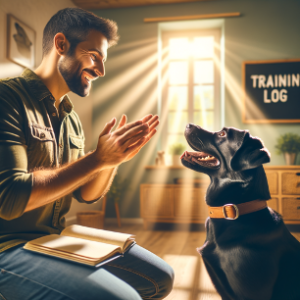
Enriching Your Dog’s Life: The Broader Benefits of Clicker Training Through Mental Stimulation and Skill Development
While we’ve explored the foundational aspects of clicker training in our previous section, it’s essential to delve deeper into the broader benefits that this training method offers. Beyond refining communication between you and your furry friend, clicker training enriches your dog’s life significantly by providing mental stimulation and fostering skill development. Let’s explore these benefits in detail.
The Importance of Mental Stimulation
Just like humans, dogs thrive on mental challenges. Engaging their minds is crucial for their overall happiness and wellbeing. Here are a few reasons why mental stimulation through clicker training is vital:
- Prevention of Behavioral Issues: Bored dogs often resort to unwanted behaviors, such as chewing furniture or excessive barking. Engaging their minds helps reduce these tendencies since they are focused on learning and interacting with you.
- Increased Focus and Calmness: Regular mental exercises can help minimize hyperactivity. A dog that challenges their mind is often calmer and more focused during training sessions.
- Enhanced Problem-Solving Skills: Through clicker training, dogs learn to think critically and solve problems. This not only aids in training but also applies to their everyday lives, as they become better at navigating their environment.
Skill Development Through Clicker Training
Clicker training isn’t just about teaching commands; it’s about facilitating a broader range of skills that will enhance your dog’s life. Here’s how clicker training fosters skill development:
- Learning New Activities: From basic commands to complex tricks, clicker training encourages dogs to learn a wide array of behaviors. This keeps training exciting and enriching, as dogs remain engaged and eager to learn more.
- Building a Repertoire of Tricks: Mastering tricks not only adds fun to your dog’s daily routine but also serves as a vital social tool. A dog that can perform a variety of tricks is sure to impress friends, family, and other dogs at the park!
- Agility and Coordination: Many dogs excel in agility courses, which require them to navigate obstacles and execute commands quickly. Incorporating clicker training helps build the coordination and focus necessary for these skills.
Real-World Examples of Mental Stimulation and Skill Development
Consider Lily, a border collie who was known for her energy and intelligence. Her owner, Tom, introduced clicker training as a way to channel her energy. With consistent training sessions, Lily not only learned commands but also mastered several advanced tricks, like jumping through hoops and fetching specific toys. The result? A happier, well-behaved dog who could enjoy outings to dog parks without exhausting her owner!
Similarly, Mia, a senior golden retriever, benefited from clicker training during her later years. Her owner, Jessica, used clicker training to encourage Mia to learn new tasks at a slower pace. This cognitive engagement kept Mia active and alert, thus improving her overall quality of life.
Actionable Tips for Using Clicker Training as Mental Stimulation
To ensure you’re getting the most out of clicker training, consider these actionable tips:
- Incorporate Variety: Change up your training routines regularly to keep your dog engaged. Alternate between tricks, commands, and agility tasks to stimulate their mind in different ways.
- Short Sessions: Keep training sessions brief but frequent—aim for 5-10 minutes at a time. This approach helps maintain your dog’s focus without overwhelming them.
- Use Puzzle Toys: Combine clicker training with puzzle toys that require your dog to think. When your dog successfully completes a challenge, use the clicker to reward their efforts!
- Challenge Them: Gradually increase the difficulty of tasks as your dog masters simpler commands. This keeps the training fresh and exciting while promoting their mental development.
Conclusion: Enhance Your Dog’s Life with Clicker Training
Understanding the broader benefits of clicker training not only highlights its effectiveness but also emphasizes its importance in enriching your dog’s life. By fostering mental stimulation and skill development, clicker training plays a pivotal role in preventing behavioral issues and enhancing the bond between you and your furry companion.

The Role of Patience and Persistence in Dog Training
As you embark on your clicker training journey, it’s essential to recognize that patience and persistence are your greatest allies. Dog training is not about achieving instantaneous results; rather, it’s a gradual process of building communication, trust, and understanding between you and your pet. Let’s explore how these two vital elements contribute to effective training and enhance the bond you share with your furry companion.
The Importance of Patience
Training a dog requires time and understanding. Here are some reasons why patience is crucial in the training process:
- Learning Curve: Just like humans, dogs learn at their own pace. Some dogs might grasp commands quickly, while others may need more time and repetition.
- Avoiding Frustration: Dogs can sense their owner’s frustrations. If you lose patience, your dog may feel discouraged and less eager to learn. Maintaining a calm demeanor helps create a safe environment for learning.
- Building Trust: Regular training sessions, even if they feel slow at times, help to strengthen the bond of trust between you and your dog. Trust fosters a willingness to engage, making them more receptive to your training efforts.
The Necessity of Persistence
Persistence is the dedication to continue training despite challenges. Here’s why it’s vital:
- Consistency is Key: Dogs thrive on routine. Regular practice is essential for reinforcing learned behaviors. Persisting in your training efforts ensures consistency in your dog’s understanding of commands.
- Overcoming Setbacks: Every dog will have off days or moments when they don’t perform as expected. Persistence helps you adapt and refine your training methods rather than giving up.
- Continuous Improvement: Just because a dog masters a command doesn’t mean the journey ends there. Persistent training can introduce new challenges, keeping your dog mentally stimulated and reinforcing previous lessons.
Strategies to Incorporate Patience and Persistence in Training
- Set Realistic Goals
Establish short-term and long-term training goals. For instance, aim to teach your dog to sit in a week, then gradually work toward more complex tricks over the next few months. Celebrating small victories breeds motivation and reinforces positive behaviors. - Incorporate Breaks
During training sessions, take short breaks to prevent your dog from becoming overwhelmed. A 5-minute session followed by a short playtime can keep both you and your dog engaged and prevent frustration. - Reflect and Adapt
After each training session, take a moment to reflect on what worked and what didn’t. If a particular method isn’t yielding the expected results, persistently seeking alternative approaches helps you find what resonates best with your dog. - Engage in Positive Reinforcement
Every time your dog makes progress, reward them! Whether it’s a treat, praise, or a game of fetch, positive reinforcement reinforces that they’re on the right track. This approach helps sustain your dog’s motivation and eagerness to learn.
Real-World Example: A Testament to Patience and Persistence
Consider the story of Lisa, a Golden Retriever owner who faced challenges training her dog, Bella. Initially, Bella struggled with commands, often getting distracted during sessions. However, Lisa remained patient and persistent, dedicating short training periods spread throughout the day. Over time, Bella began to respond positively, not only mastering commands but also showing an eagerness to engage in training sessions with Lisa.
Lisa’s dedication showcased the power of combining patience and persistence. After months of training, Bella excelled not just in basic commands; she ventured into agility classes, earning ribbons in local competitions. This journey reaffirmed that with time, love, and consistent effort, any hurdle can be overcome.
The Journey of Communication: A Shared Experience
The journey of dog training is not merely about teaching commands but establishing a shared language between you and your dog. Embrace the learning curve, celebrate each small victory, and trust that both patience and persistence will reap immeasurable rewards.
As you continue your clicker training adventure, remember that progress may take time; however, the bonds you create along the way will be well worth the effort.

Conclusion: Final Thoughts on Clicker Training
In summary, clicker training is more than just a technique; it’s a powerful means of enhancing communication between you and your dog, leading to a happier, healthier relationship. Throughout this blog post, we’ve explored various aspects of clicker training that contribute to its effectiveness.
Key Takeaways
- Purpose of Clicker Training: Utilizing a clicker helps bridge the communication gap between you and your dog, providing a distinct signal for desired behaviors. This clarity promotes a better understanding of commands and fosters learning.
- Science of Learning: Rooted in operant conditioning, clicker training employs positive reinforcement to encourage good behavior. Studies suggest that this method results in faster learning and a more motivated learner.
- Benefits of Clicker Training: Engaging in clicker training sessions creates a positive, nurturing environment. From improving communication to strengthening your bond, the advantages are clear and impactful.
- Getting Started: Following the practical steps provided—choosing the right clicker, introducing it effectively, starting with simple commands, and gradually increasing complexity—will set you on a path to success.
- Real-World Impact: Just like Sarah and Jake, many dog owners are finding new joy in the training process through clicker training, resulting in well-behaved, happy dogs.
Clicker training is an effective, enjoyable way to engage with your dog, promoting a mutual understanding and a loving relationship. Remember, consistency and patience are key as you embark on this training journey.
news via inbox
Nulla turp dis cursus. Integer liberos euismod pretium faucibua


